Nancy Marie Brown's Blog, page 3
October 6, 2021
Men of Terror
"Sometime near the end of the tenth century, a man named Fraði died in Sweden. His kinsmen raised a granite runestone in his memory in Denmark. Although the message carved into the stone is hard to interpret, it appears to tell us that Fraði was the first among all Vikings and that he was the terror of men. What did Fraði do in his lifetime that made him so admired…?"
So begins Men of Terror: A Comprehensive Analysis of Viking Combat by William R. Short and Reynir A. Óskarson.
Emphasis on the "comprehensive." If you have any interest in Viking Age weapons or fighting techniques, or are curious if the heroes in the Icelandic Sagas could really have performed their heroic feats, this 350-page, 2-column book is the one to reach for.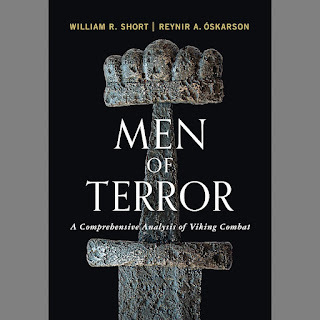
It's got everything (with one exception, which we'll get to later): the Viking mindset, shields and armor, battle tactics, raiding and dueling...
Sax, axe, sword, spear, bow and arrows: Short and Óskarson describe each weapon in great detail--enough that you can make one, if you have the skills and materials--and give copious examples from the sagas, myths, and other literary sources of how each weapon was used and thought of. Numerous illustrations and charts complement their descriptions.
But what really makes Men of Terror stand out from similar books on Viking Age weaponry are the sections on the "physics of" each weapon.
The long, single-edged knife called a sax (or, less correctly, a scramasax), for example, is "a robust, trusty weapon." Designed for hacking (not stabbing), a sax, compared to a sword, is "less likely to break or fail when abused."
But it takes more raw strength to kill with a sax.
Here's why: "Compared to other cutting weapons such as the axe and sword, the sax is generally shorter and lighter, with most of the mass distributed closer to the hand than to the tip. A computer model of the weapon shows the smaller effective mass at the contact point and the lower linear velocities at impact together result in less energy delivered to the target when cutting with a sax compared to cutting with an axe or a sword, all other things being equal. Measurements confirm the model. The energy delivered by a replica sax to a target measured about 40 percent less than the energy delivered by a replica sword, not dissimilar to what the computer model predicted."
Follow the footnotes and you can peer into Short's Viking research studio, Hurstwic, in Massachusetts. There, he and his team attached a three-axis accelerometer to a heavy boxing-type bag (fixed so it couldn't swing). Multiple fighters attacked the target on the bag multiple times, with a replica sax, sword, one-handed axe, and two-handed axe. The data was recorded, checked, averaged, and then compared to a computer model built from the physical parameters of each weapon and how the hand grasps it.
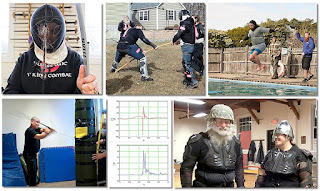 Caption: Scenes from the Hurstwic Facebook page.
Caption: Scenes from the Hurstwic Facebook page.
Did I mention Short is a research scientist with a degree from MIT and dozens of patents? His approach to reverse-engineering Viking combat techniques, he explains, is to "create a hypothesis that can be tested" and then to test it again and again. If you want data, this book has it.
The physics of the sax may explain why saxes are so rare in Viking sources. Archaeologists in Norway, for example, count 130 swords for every sax they find and, according to Short's own calculations, "only about 6 percent of the attacks in the [Icelandic Family] sagas are made with saxes." Perhaps also, he and Óskarson speculate, "it is for this reason that saxes were the prized weapon of jötnar (giants), ghosts, and men who had the strength of a giant."
Strength was also the deciding factor, Short and Óskarson argue, in wrestling or "empty-hand combat." In the sagas, this type of fighting is called glíma or fang. It is "the only combative activity alive today that holds a documented, nearly unbroken line that can be traced back to the Vikings," they say, but warn that the art has changed. "In the Viking Age, strength and power were valued in a wrestler," they argue, "but in modern glíma, finesse, agility, and beauty are what is most prized."
Viking fang "was a test of a man’s strength in a society that placed a premium on strength." It was the sport of Thor, the strongest of the gods.
As such, it "gives us clues about the mindset of the Vikings in combat," say Short and Óskarson. Wrestlers "need to be constantly on alert." They need to act "with 100 percent determination.... A warrior who has as his basis or foundation an aggressive, power-based wrestling would stand differently than a warrior who has as his basis a more technical system of wrestling or a striking art. A fighter’s lowering his center of gravity and adhering strictly to the most functional way to keep his balance gives us clues as to how he would stand in a combative situation.... The core of fang centered on raw power, swift movement, and cunning."
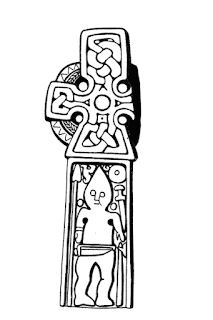 Some readers (like me) may have been annoyed by the sexist language in these quotations from
Men of Terror
. They are not a mistake.
Men of Terror
is a book-length argument against my thesis, in
The Real Valkyrie
, that women could be warriors in the Viking Age. Despite the fact that Thor's opponent in his famous wrestling match (as Short and Óskarson do point out) is a woman--the old giant woman Elli, a personification of old age--they believe Viking warriors were men: "men of terror."
Some readers (like me) may have been annoyed by the sexist language in these quotations from
Men of Terror
. They are not a mistake.
Men of Terror
is a book-length argument against my thesis, in
The Real Valkyrie
, that women could be warriors in the Viking Age. Despite the fact that Thor's opponent in his famous wrestling match (as Short and Óskarson do point out) is a woman--the old giant woman Elli, a personification of old age--they believe Viking warriors were men: "men of terror."
Their book's title comes from a runestone cited and translated in the Samnordisk rune-text database. It begins: "Ástráðr and Hildungr raised this stone in memory of Fraði, their kinsmen. And he was then the terror of men."
The word translated as "of men" is vera. This word can also mean "of people." It is used, for example, in veröld, which means “world,” with öld meaning “time” or “age.” Thus veröld literally means “the age of humans” or “the time of humans,” i.e. what we now call the anthropocene. Ver is also used in compounds like Oddaverjar, or “people/family of Oddi.” You wouldn’t translate ver today to mean only masculine humans. It refers to all people--which is what “men” used to mean when the first translations from Old Norse to English were made, as in “good will to all men."
So instead of "Men of Terror," I would call Short and Óskarson's book, "People of Terror"--or would I?
Let's not be ridiculous. A title is a marketing tool, and "Men of Terror" is much catchier.
In Men of Terror , Short and Óskarson are simply focusing on men like I focused on women in The Real Valkyrie . Not to exclude the other sex, but to zero in on this particular elite cohort of Viking Age people: men of terror, i.e. professional male warriors with the strength of giants.
Short and Óskarson don’t need to talk about women warriors—I did that (and Short knows it; he even gave me a nice blurb for the book cover). They also don’t talk about male craftsmen or farmers or old men or boys, etc. Their focus is on what made these particular men terrible. If writing books about exceptional Viking women is justified, so is writing books about exceptional Viking men.
Men of Terror is a rich and stimulating--and yes, comprehensive!--look at one important aspect of life in the Viking Age. It deserves to be a classic.
To leave you with one last example of the many quirky questions the book answers, do you remember the episode in Njal's Saga where Gunnar is using his bow to fend off the enemies encircling his house when his bowstring breaks? He asks his wife for two strands of her beautiful long hair to braid into a bowstring, and she refuses--dooming him to death.
Could that have worked? Can you make a bowstring out of human hair? Flip to page 120 of Men of Terror and read: "The feasibility of using human hair was tested in our research lab by gathering hair, twisting it into a string, and splicing it into a conventional bowstring that had been cut. Measurements showed no significant change in power delivered or accuracy of the shooting when using a string made of human hair. These experiments showed the possibility of using human hair to repair a bowstring."
Brilliant! I've always wanted to know that.
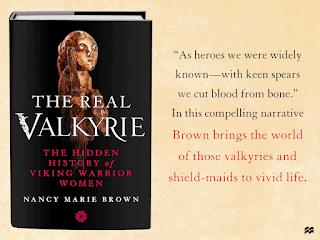 For more on my book
The Real Valkyrie: The Hidden History of Viking Warrior Women
, see the previous posts on this blog (click here) or my page at Macmillan.com.
For more on my book
The Real Valkyrie: The Hidden History of Viking Warrior Women
, see the previous posts on this blog (click here) or my page at Macmillan.com.
Disclosure: I am an affiliate of Bookshop.org and may earn a commission if you click through and purchase the books mentioned here.
So begins Men of Terror: A Comprehensive Analysis of Viking Combat by William R. Short and Reynir A. Óskarson.
Emphasis on the "comprehensive." If you have any interest in Viking Age weapons or fighting techniques, or are curious if the heroes in the Icelandic Sagas could really have performed their heroic feats, this 350-page, 2-column book is the one to reach for.

It's got everything (with one exception, which we'll get to later): the Viking mindset, shields and armor, battle tactics, raiding and dueling...
Sax, axe, sword, spear, bow and arrows: Short and Óskarson describe each weapon in great detail--enough that you can make one, if you have the skills and materials--and give copious examples from the sagas, myths, and other literary sources of how each weapon was used and thought of. Numerous illustrations and charts complement their descriptions.
But what really makes Men of Terror stand out from similar books on Viking Age weaponry are the sections on the "physics of" each weapon.
The long, single-edged knife called a sax (or, less correctly, a scramasax), for example, is "a robust, trusty weapon." Designed for hacking (not stabbing), a sax, compared to a sword, is "less likely to break or fail when abused."
But it takes more raw strength to kill with a sax.
Here's why: "Compared to other cutting weapons such as the axe and sword, the sax is generally shorter and lighter, with most of the mass distributed closer to the hand than to the tip. A computer model of the weapon shows the smaller effective mass at the contact point and the lower linear velocities at impact together result in less energy delivered to the target when cutting with a sax compared to cutting with an axe or a sword, all other things being equal. Measurements confirm the model. The energy delivered by a replica sax to a target measured about 40 percent less than the energy delivered by a replica sword, not dissimilar to what the computer model predicted."
Follow the footnotes and you can peer into Short's Viking research studio, Hurstwic, in Massachusetts. There, he and his team attached a three-axis accelerometer to a heavy boxing-type bag (fixed so it couldn't swing). Multiple fighters attacked the target on the bag multiple times, with a replica sax, sword, one-handed axe, and two-handed axe. The data was recorded, checked, averaged, and then compared to a computer model built from the physical parameters of each weapon and how the hand grasps it.
 Caption: Scenes from the Hurstwic Facebook page.
Caption: Scenes from the Hurstwic Facebook page. Did I mention Short is a research scientist with a degree from MIT and dozens of patents? His approach to reverse-engineering Viking combat techniques, he explains, is to "create a hypothesis that can be tested" and then to test it again and again. If you want data, this book has it.
The physics of the sax may explain why saxes are so rare in Viking sources. Archaeologists in Norway, for example, count 130 swords for every sax they find and, according to Short's own calculations, "only about 6 percent of the attacks in the [Icelandic Family] sagas are made with saxes." Perhaps also, he and Óskarson speculate, "it is for this reason that saxes were the prized weapon of jötnar (giants), ghosts, and men who had the strength of a giant."
Strength was also the deciding factor, Short and Óskarson argue, in wrestling or "empty-hand combat." In the sagas, this type of fighting is called glíma or fang. It is "the only combative activity alive today that holds a documented, nearly unbroken line that can be traced back to the Vikings," they say, but warn that the art has changed. "In the Viking Age, strength and power were valued in a wrestler," they argue, "but in modern glíma, finesse, agility, and beauty are what is most prized."
Viking fang "was a test of a man’s strength in a society that placed a premium on strength." It was the sport of Thor, the strongest of the gods.
As such, it "gives us clues about the mindset of the Vikings in combat," say Short and Óskarson. Wrestlers "need to be constantly on alert." They need to act "with 100 percent determination.... A warrior who has as his basis or foundation an aggressive, power-based wrestling would stand differently than a warrior who has as his basis a more technical system of wrestling or a striking art. A fighter’s lowering his center of gravity and adhering strictly to the most functional way to keep his balance gives us clues as to how he would stand in a combative situation.... The core of fang centered on raw power, swift movement, and cunning."
 Some readers (like me) may have been annoyed by the sexist language in these quotations from
Men of Terror
. They are not a mistake.
Men of Terror
is a book-length argument against my thesis, in
The Real Valkyrie
, that women could be warriors in the Viking Age. Despite the fact that Thor's opponent in his famous wrestling match (as Short and Óskarson do point out) is a woman--the old giant woman Elli, a personification of old age--they believe Viking warriors were men: "men of terror."
Some readers (like me) may have been annoyed by the sexist language in these quotations from
Men of Terror
. They are not a mistake.
Men of Terror
is a book-length argument against my thesis, in
The Real Valkyrie
, that women could be warriors in the Viking Age. Despite the fact that Thor's opponent in his famous wrestling match (as Short and Óskarson do point out) is a woman--the old giant woman Elli, a personification of old age--they believe Viking warriors were men: "men of terror." Their book's title comes from a runestone cited and translated in the Samnordisk rune-text database. It begins: "Ástráðr and Hildungr raised this stone in memory of Fraði, their kinsmen. And he was then the terror of men."
The word translated as "of men" is vera. This word can also mean "of people." It is used, for example, in veröld, which means “world,” with öld meaning “time” or “age.” Thus veröld literally means “the age of humans” or “the time of humans,” i.e. what we now call the anthropocene. Ver is also used in compounds like Oddaverjar, or “people/family of Oddi.” You wouldn’t translate ver today to mean only masculine humans. It refers to all people--which is what “men” used to mean when the first translations from Old Norse to English were made, as in “good will to all men."
So instead of "Men of Terror," I would call Short and Óskarson's book, "People of Terror"--or would I?
Let's not be ridiculous. A title is a marketing tool, and "Men of Terror" is much catchier.
In Men of Terror , Short and Óskarson are simply focusing on men like I focused on women in The Real Valkyrie . Not to exclude the other sex, but to zero in on this particular elite cohort of Viking Age people: men of terror, i.e. professional male warriors with the strength of giants.
Short and Óskarson don’t need to talk about women warriors—I did that (and Short knows it; he even gave me a nice blurb for the book cover). They also don’t talk about male craftsmen or farmers or old men or boys, etc. Their focus is on what made these particular men terrible. If writing books about exceptional Viking women is justified, so is writing books about exceptional Viking men.
Men of Terror is a rich and stimulating--and yes, comprehensive!--look at one important aspect of life in the Viking Age. It deserves to be a classic.
To leave you with one last example of the many quirky questions the book answers, do you remember the episode in Njal's Saga where Gunnar is using his bow to fend off the enemies encircling his house when his bowstring breaks? He asks his wife for two strands of her beautiful long hair to braid into a bowstring, and she refuses--dooming him to death.
Could that have worked? Can you make a bowstring out of human hair? Flip to page 120 of Men of Terror and read: "The feasibility of using human hair was tested in our research lab by gathering hair, twisting it into a string, and splicing it into a conventional bowstring that had been cut. Measurements showed no significant change in power delivered or accuracy of the shooting when using a string made of human hair. These experiments showed the possibility of using human hair to repair a bowstring."
Brilliant! I've always wanted to know that.
 For more on my book
The Real Valkyrie: The Hidden History of Viking Warrior Women
, see the previous posts on this blog (click here) or my page at Macmillan.com.
For more on my book
The Real Valkyrie: The Hidden History of Viking Warrior Women
, see the previous posts on this blog (click here) or my page at Macmillan.com. Disclosure: I am an affiliate of Bookshop.org and may earn a commission if you click through and purchase the books mentioned here.
Published on October 06, 2021 08:07
September 29, 2021
Valkyrie: The Women of the Viking World
In the classic "raiders vs. traders" approach to Viking history, women hardly got a mention. They stayed home and looked after the farm (with all that entails) while the men went off on adventures. In the 1990s, three books by Judith Jesch and Jenny Jochens brought the lives of these women out of the shadows, showing how vital their role was, both economically (as weavers of cloth) and socially (as keepers of traditions).
In Valkyrie: The Women of the Viking World , published in 2020, Jóhanna Kristín Friðriksdóttir brings these early studies up to date, incorporating the recent archaeological studies that have shifted, or reinforced, our understanding of Viking women’s lives.
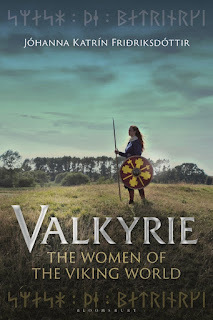 Jóhanna is an excellent storyteller, and she knows her material. She wants to introduce us, she says, “to the diverse and fascinating texts recorded in medieval Iceland, a culture able to imagine women in all kinds of roles carrying power, not just in this world but … as pulling the strings in the otherworld, too.”
Jóhanna is an excellent storyteller, and she knows her material. She wants to introduce us, she says, “to the diverse and fascinating texts recorded in medieval Iceland, a culture able to imagine women in all kinds of roles carrying power, not just in this world but … as pulling the strings in the otherworld, too.”
With her mastery of details from the Icelandic sagas, Friðriksdóttir follows ordinary Viking women through the life cycle, from birth to death. She tells stories of women who are bold and successful, but also of those who are battered and victimized.
She tells stories of some of my favorite saga women, such as Gudríðr Þorbjarnardóttir, whom Jóhanna describes as "wife, leader, traveller, mother, Christian ... the Viking woman embodied." Gudríðr, who explored North America 500 years before Columbus, is the subject of my books The Far Traveler and The Saga of Gudrid the Far-Traveler .
She tells about Hallgerðr, who "was beautiful and tall, with hair as fine as silk" and "the eyes of a thief." Her "strong sense of self-worth" and turbulent marriage result in one of the most memorable scenes in the sagas, when her husband breaks his bowstring and she refuses him a lock of hair to fashion into a new one. His enemies kill him while she stands by, and "the episode leaves us wondering whether things could have been different," Jóhanna writes. "The saga offers no answers, but it does tell us that the Icelanders kept alive the debate ... about how to balance the conflicting demands created by marriage and close male friendship."
Jóhanna also grapples with the woman at the heart of my book The Real Valkyrie: The Hidden History of Viking Warrior Woman , and supplies a contradictory--and balancing--approach to mine. Discussing the DNA analysis that found the skeleton buried in grave Bj581 in Birka, Sweden--long considered to be the ultimate Viking warrior burial--to be female, Jóhanna asks, "Now that the person who once lay in the Birka grave has been proven to have been biologically female, what do we do with this information?"
She answers that question one way, I choose another, but both deserve to be heard. It's time for Viking scholars and enthusiasts to accept that there would be no Vikings (or any other people) without women and to begin to investigate women’s lives as thoroughly as those of men.
To understand the lives of women in the Viking Age, Valkyrie: The Women of the Viking World by Jóhanna Kristín Friðriksdóttir (Bloomsbury Academic, 2020) is an excellent place to start.
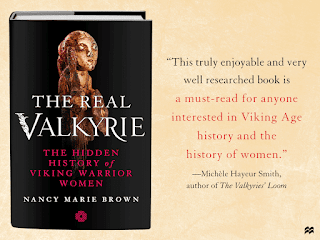 For more on my book
The Real Valkyrie: The Hidden History of Viking Warrior Women
, see the previous posts on this blog (click here) or my page at Macmillan.com.
For more on my book
The Real Valkyrie: The Hidden History of Viking Warrior Women
, see the previous posts on this blog (click here) or my page at Macmillan.com.
Disclosure: I am an affiliate of Bookshop.org and I may earn a commission if you click through and purchase the books mentioned here.
In Valkyrie: The Women of the Viking World , published in 2020, Jóhanna Kristín Friðriksdóttir brings these early studies up to date, incorporating the recent archaeological studies that have shifted, or reinforced, our understanding of Viking women’s lives.
 Jóhanna is an excellent storyteller, and she knows her material. She wants to introduce us, she says, “to the diverse and fascinating texts recorded in medieval Iceland, a culture able to imagine women in all kinds of roles carrying power, not just in this world but … as pulling the strings in the otherworld, too.”
Jóhanna is an excellent storyteller, and she knows her material. She wants to introduce us, she says, “to the diverse and fascinating texts recorded in medieval Iceland, a culture able to imagine women in all kinds of roles carrying power, not just in this world but … as pulling the strings in the otherworld, too.” With her mastery of details from the Icelandic sagas, Friðriksdóttir follows ordinary Viking women through the life cycle, from birth to death. She tells stories of women who are bold and successful, but also of those who are battered and victimized.
She tells stories of some of my favorite saga women, such as Gudríðr Þorbjarnardóttir, whom Jóhanna describes as "wife, leader, traveller, mother, Christian ... the Viking woman embodied." Gudríðr, who explored North America 500 years before Columbus, is the subject of my books The Far Traveler and The Saga of Gudrid the Far-Traveler .
She tells about Hallgerðr, who "was beautiful and tall, with hair as fine as silk" and "the eyes of a thief." Her "strong sense of self-worth" and turbulent marriage result in one of the most memorable scenes in the sagas, when her husband breaks his bowstring and she refuses him a lock of hair to fashion into a new one. His enemies kill him while she stands by, and "the episode leaves us wondering whether things could have been different," Jóhanna writes. "The saga offers no answers, but it does tell us that the Icelanders kept alive the debate ... about how to balance the conflicting demands created by marriage and close male friendship."
Jóhanna also grapples with the woman at the heart of my book The Real Valkyrie: The Hidden History of Viking Warrior Woman , and supplies a contradictory--and balancing--approach to mine. Discussing the DNA analysis that found the skeleton buried in grave Bj581 in Birka, Sweden--long considered to be the ultimate Viking warrior burial--to be female, Jóhanna asks, "Now that the person who once lay in the Birka grave has been proven to have been biologically female, what do we do with this information?"
She answers that question one way, I choose another, but both deserve to be heard. It's time for Viking scholars and enthusiasts to accept that there would be no Vikings (or any other people) without women and to begin to investigate women’s lives as thoroughly as those of men.
To understand the lives of women in the Viking Age, Valkyrie: The Women of the Viking World by Jóhanna Kristín Friðriksdóttir (Bloomsbury Academic, 2020) is an excellent place to start.
 For more on my book
The Real Valkyrie: The Hidden History of Viking Warrior Women
, see the previous posts on this blog (click here) or my page at Macmillan.com.
For more on my book
The Real Valkyrie: The Hidden History of Viking Warrior Women
, see the previous posts on this blog (click here) or my page at Macmillan.com. Disclosure: I am an affiliate of Bookshop.org and I may earn a commission if you click through and purchase the books mentioned here.
Published on September 29, 2021 08:00
September 22, 2021
Did Vikings Get Seasick?
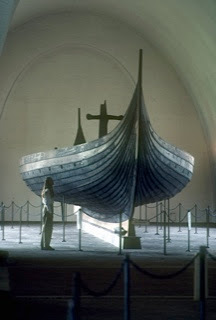 I get seasick. Really seasick. So to write about sailing a Viking ship, as I've done extensively in my new book,
The Real Valkyrie
, as well as in my earlier books about Gudrid the Far-Traveler's exploration of North America around the year 1000, I didn't try to recreate a Viking voyage.
I get seasick. Really seasick. So to write about sailing a Viking ship, as I've done extensively in my new book,
The Real Valkyrie
, as well as in my earlier books about Gudrid the Far-Traveler's exploration of North America around the year 1000, I didn't try to recreate a Viking voyage. Sure, I got on Viking ships. I rowed the Viking fishing boat Kraka Fyr in Roskilde harbor. (You can read about that adventure here.)
And I tooled around the harbor of Newport, Rhode Island in Gaia, a replica of the Gokstad ship. (See "A Viking Ship at Midnight," here.)
But mostly, I visited Viking ships in museums and read books by and about other people who had tried to recreate voyages in replica Viking ships.
One of my favorite passages is from Hodding Carter's A Viking Voyage: In which an unlikely crew of adventurers attempts an epic journey to the New World. (Really, the subtitle tells you all you need to know.) This scene (greatly abbreviated here) takes place just before their replica knarr, called Snorri, had to be towed back to Greenland by the Coast Guard Canada.
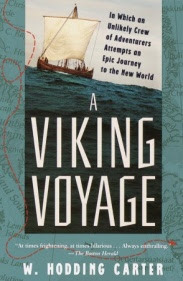
Writes Carter: "Each swell that rocked Snorri, each wave that slapped her across the sheer plank and sprayed over the foredeck--I cherished them all. We were finally attempting something ancient. We had left the safety net of land and civilization. For the Vikings, this had been THE moment ... I felt unbound. 'This is THE MOMENT,' I kept telling myself. I suddenly fell in love not only with sailing but also with the ocean. I liked being at its mercy. ... The water shifted colors again and again. ... Sounds competed for attention. ... I could not sleep that night. ... I knew then why Leif and the others sailed west--not for wood or new land, but merely to feel so much at once. ... By seven the next evening we were more than 130 miles from Greenland, adrift. All that bashing and groaning I had so cherished had taken its toll. Some of the crew were falling apart. Rob was retching wherever he stood. Others were nearly as sick. Snorri was faring even worse. Our huge rudder had loosened a supporting crossbeam, a thigh-thick piece of wooden framing, by constantly pulling forward on it, instantly creating four holes in the bottom of the boat. Water gushed in..."
No need to read farther, I thought. I'm not going to cross an ocean on a Viking ship. Not me.
Several years later, between the publication of The Far Traveler (2007) and that of my YA novel based on that research, The Saga of Gudrid the Far-Traveler (2015), I had the good fortune to meet the retching Rob of Carter's story. When I asked him about his seasickness, he laughed it off. “Great way to lose 40 or 50 pounds.” (You can read more about Rob Stevens, the boatbuilder who built the knarr replica for Carter, .)
As I said then, I would rather fall off a horse (and I have, repeatedly; read about that here) than be seasick.
But from what archaeologists reexamining the Gokstad ship discovered recently, it seems the bigger hazard for a sailor on a Viking ship was getting bored.
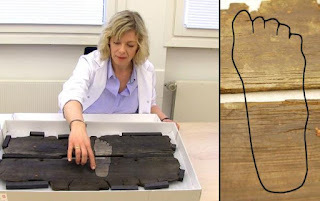 Photo caption: Hanne Lovise Aannestad of the Museum of Cultural History in Oslo points at the footprint on a board of the Gokstad ship. The footprint is enhanced by Science Nordic (photo by Hanne Jakobsen/Per Byhring)
Photo caption: Hanne Lovise Aannestad of the Museum of Cultural History in Oslo points at the footprint on a board of the Gokstad ship. The footprint is enhanced by Science Nordic (photo by Hanne Jakobsen/Per Byhring)According to a 2013 story in Science Nordic, carved into the original floorboards of this Viking ship buried in about 900 in the blue clay of southern Norway are two footprints. They were discovered in 2009, when museum workers were preparing to transfer the floorboards into a new exhibit space.
"My guess is that some time or another a person was bored and simply traced his foot with his knife. It's a kind of an 'I was here' message," researcher Hanne Lovise Aannestad of the Museum of Cultural History in Oslo told Science Nordic.
The footprints are quite small--smaller than Aannestad's--perhaps a girl's? The more distinct of the two prints is a right foot, bare. It even includes toenails. A weaker outline of a left foot appears on another plank. Was it the same girl's? Since the loose floorboards were scattered when the ship was excavated, it's impossible to say. So there might have been two bored young people on the Gokstad ship.
Or maybe they were trying to take their minds off being seasick.
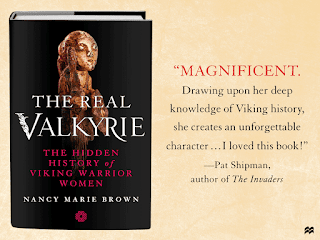 To learn how I used those footprints to tell the story of a warrior woman sailing to Birka in the 10th century, see Chapter 13 of my book
The Real Valkyrie: The Hidden History of Viking Warrior Women
. To learn more about the book, see the previous posts on this blog (here) or my page at Macmillan.com.
To learn how I used those footprints to tell the story of a warrior woman sailing to Birka in the 10th century, see Chapter 13 of my book
The Real Valkyrie: The Hidden History of Viking Warrior Women
. To learn more about the book, see the previous posts on this blog (here) or my page at Macmillan.com. Disclosure: I am an affiliate of Bookshop.org and I may earn a commission if you click through and purchase the books mentioned here.
Published on September 22, 2021 08:00
September 15, 2021
The Science Behind the Real Valkyrie
What does the Viking world look like if we abandon our ideas of gender? What does it look like if roles are assigned, not according to concepts of male versus female, but based on ambition, ability, family ties, and wealth?
In my new book, The Real Valkyrie: The Hidden History of Viking Warrior Women , I reread medieval texts and reexamine archaeological finds with these questions in mind. I use what my research uncovers to re-create the world of one warrior woman in the Viking Age.
As I've written earlier on this blog (click here to read "The Story Behind the Real Valkyrie"), The Real Valkyrie is inspired by "A Female Viking Warrior Confirmed by Genomics," published in 2017 in the American Journal of Physical Anthropology by Charlotte Hedenstierna-Jonson, Neil Price, and their colleagues, and by their follow-up paper in Antiquity in 2019.
The warrior whose bones they analyze was taken in 1878 from grave Bj581 in the town of Birka, Sweden, a rich weapons-grave long thought to be the ultimate Viking warrior burial.
We don’t know the name of this valkyrie, so I’ve given her one: I call her Hervor, after the warrior woman in a classic Old Norse poem. Her means “battle.” Vör means “aware.” Hervor, then, means Aware of Battle, or Warrior Woman.
 What can modern science reveal about her? Her bones and teeth tell us Hervor was 30 to 40 when she died. She ate well all her life, which means she came from a rich family, if not a royal one. At over 5 foot 7, she was taller than most people around her: 5 foot 5 was the average height of a man in 10th century Scandinavia.
What can modern science reveal about her? Her bones and teeth tell us Hervor was 30 to 40 when she died. She ate well all her life, which means she came from a rich family, if not a royal one. At over 5 foot 7, she was taller than most people around her: 5 foot 5 was the average height of a man in 10th century Scandinavia.
The chemistry of her teeth tell us that she was not a native of Birka, where she was buried, but came from somewhere in southern Sweden or Norway. She sailed from there, before she was eight, but did not arrive in Birka until she was over 16.
What was she like? Where did she travel? If all I had were her bones, I could only wonder. But I can also study what was buried with her.
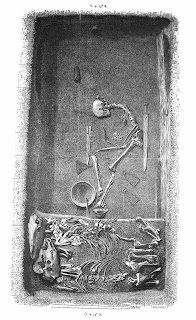 She was seated in her grave surrounded by weapons. None of them are fancy. None are simply for show.
She was seated in her grave surrounded by weapons. None of them are fancy. None are simply for show.
Her two-edged sword is a type rare in Norway and Sweden, but more often found along the Vikings' East Way, the trade route through what is now Russia and Ukraine to Byzantium and beyond.
Her long, thin-bladed scramasax, in its elaborate bronze-and-silver ornamented sheath, is also eastern, inspired by the equipment of the Magyar horse archers who harassed the Vikings along the East Way.
Hervor was an archer too, and may have shot from horseback. Only 18 graves at Birka contain a horse—and she has two, both with bridles. Her iron stirrups are all that remain of her saddle.
By her side were 25 armor-piercing arrows. Between the arrows and her scramasax was a bare spot the right shape for a bow, which had disintegrated. It may have been a Magyar bow—the distinctive metal rings and fittings of Magyar bow cases and quivers were recovered from other Birka graves. Magyar bows were composites of wood, sinew, and horn, bent into a reflex shape. Small and handy on horseback, they shot twice as far as an ordinary wooden bow.
But Hervor was not solely a mounted archer. She was buried with almost every Viking weapon known: sword, scramasax, arrows and bow, axe, two spears, and two shields.
She was buried with more weapons than any other warrior in Birka—more than almost every Viking in the world. Of those Vikings found buried with any weapons at all, 61% have one weapon; only 15% have three or more.
A final touch elevates her rank from warrior to war leader: the full set of pieces for the board game hnefatafl, or Viking chess, that was placed in her lap. From the Roman Iron Age through the high medieval era, from Iceland to Africa to Japan, the combination of game pieces, weapons, and horses in a grave has indicated a war leader. Game pieces symbolize authority and a "flair for strategic thinking," experts say. They express the idea that success in warfare does not depend on strength alone, but also on tactical skill and good luck.
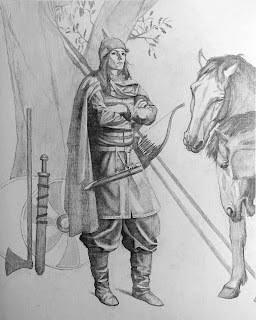 What did Hervor wear? Based on what little remains of her clothing, Hervor dressed like the other Birka warriors in the 10th century. They affected an urban style, distinctive to the fortress towns along the East Way. It was a mixture of Viking, Slavic, steppe-nomadic, and Byzantine fashion, as can be seen in this drawing commissioned by Neil Price and his colleagues.
What did Hervor wear? Based on what little remains of her clothing, Hervor dressed like the other Birka warriors in the 10th century. They affected an urban style, distinctive to the fortress towns along the East Way. It was a mixture of Viking, Slavic, steppe-nomadic, and Byzantine fashion, as can be seen in this drawing commissioned by Neil Price and his colleagues.
Under a classic Viking cloak, clasped with a ring-shaped iron pin at one shoulder, Hervor wore a nomad's kaftan. It might have been made of Byzantine silk: In her grave was a scrap of fabric woven from silk and silver threads. It might have been decorated with mirrored sequins, a scattering of which were also found in her grave.
On her head she wore a silk cap, topped by a filigreed silver cone. Only the cone and a scrap of silk remain of Hervor's cap, but an exact match for her cap's cone was buried with another Birka warrior. A third matching cone was buried with a warrior near Kyiv.
Who was this valkyrie buried in grave Bj581? To tell Hervor's story, I had to make assumptions. I had to connect the dots.
Her bones say she lived to be 30 or 40. Archaeologists can rarely date their finds within a span of 30 years. The items in her grave suggest she died when Birka was at its height and its connections to the East Way were strongest.
The location of her grave implies she was buried after the Warrior's Hall was built for Birka's garrison, between 930 and 950, but before it burned down, between 965 and 985. To tell the best story, I've guessed Hervor was buried a little after 960 and born around 930.
Where was she born? Science tells me only that she came from southern Sweden or Norway. Looking at the Viking world from a warrior woman's point of view, I've opted for Vestfold. Here, a hundred years before Hervor's birth, two powerful women were buried in the most lavish Viking grave ever uncovered, the Oseberg ship mound.
Here, when Hervor was a child, the great hall guarding the cosmopolitan town of Kaupang was destroyed—perhaps by Eirik Bloodaxe and Gunnhild Mother-of-Kings, who conquered Vestfold around that time.
Where would a small girl, born in Kaupang to a rich family, if not royal, end up? Science suggests she went west, possibly to the British Isles—as did Eirik and Gunnhild sometime between 935 and 946, having lost Norway's throne. From their base in the Orkney islands, the royal pair meddled in the politics of Dublin and York.
I don't know how or when Hervor arrived in Birka. But she did arrive sometime in the mid-900s and was buried there as a war leader. Before her death, I imagine she traveled on the East Way from Birka to Kyiv and back, assuming Kyiv is where she got the silver cone for her silk cap.
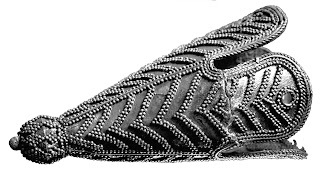 Besides my conjectural outline of Hervor's life, what links Dublin and York to Kaupang, Birka, and Kyiv? The Viking slave trade, through which young men and women were exchanged for Byzantine silk and Arab silver.
Besides my conjectural outline of Hervor's life, what links Dublin and York to Kaupang, Birka, and Kyiv? The Viking slave trade, through which young men and women were exchanged for Byzantine silk and Arab silver.
In Kyiv, Hervor may have met Queen Olga, who ruled the Vikings, or Rus, from 945 until 957. Her story, once labeled “picturesque” and “legendary,” has been proved by archaeologists to “contain a core of historical truth.”
What I learned researching The Real Valkyrie leads me to believe there is also a core of truth in the account of a battle between the Rus and the Byzantine (or Roman) army in 971. As the victors were "robbing the corpses," wrote John Skylitzes in his Synopsis of Byzantine History a hundred years later, “they found women lying among the fallen, equipped like men; women who had fought against the Romans together with the men.”
Our Hervor was not among them. She had already been buried, surrounded by weapons, in Birka grave Bj581. But as Charlotte Hedenstierna-Jonson and her colleagues write, Bj581 “suggests to us that at least one Viking Age woman adopted a professional warrior lifestyle. We would be very surprised if she was alone in the Viking world.” So would I.
 For more on my book
The Real Valkyrie: The Hidden History of Viking Warrior Women
, see the previous posts on this blog (click here) or my page at Macmillan.com.
For more on my book
The Real Valkyrie: The Hidden History of Viking Warrior Women
, see the previous posts on this blog (click here) or my page at Macmillan.com.
Disclosure: I am an affiliate of Bookshop.org and I may earn a commission if you click through and purchase the books mentioned here.
In my new book, The Real Valkyrie: The Hidden History of Viking Warrior Women , I reread medieval texts and reexamine archaeological finds with these questions in mind. I use what my research uncovers to re-create the world of one warrior woman in the Viking Age.
As I've written earlier on this blog (click here to read "The Story Behind the Real Valkyrie"), The Real Valkyrie is inspired by "A Female Viking Warrior Confirmed by Genomics," published in 2017 in the American Journal of Physical Anthropology by Charlotte Hedenstierna-Jonson, Neil Price, and their colleagues, and by their follow-up paper in Antiquity in 2019.
The warrior whose bones they analyze was taken in 1878 from grave Bj581 in the town of Birka, Sweden, a rich weapons-grave long thought to be the ultimate Viking warrior burial.
We don’t know the name of this valkyrie, so I’ve given her one: I call her Hervor, after the warrior woman in a classic Old Norse poem. Her means “battle.” Vör means “aware.” Hervor, then, means Aware of Battle, or Warrior Woman.
 What can modern science reveal about her? Her bones and teeth tell us Hervor was 30 to 40 when she died. She ate well all her life, which means she came from a rich family, if not a royal one. At over 5 foot 7, she was taller than most people around her: 5 foot 5 was the average height of a man in 10th century Scandinavia.
What can modern science reveal about her? Her bones and teeth tell us Hervor was 30 to 40 when she died. She ate well all her life, which means she came from a rich family, if not a royal one. At over 5 foot 7, she was taller than most people around her: 5 foot 5 was the average height of a man in 10th century Scandinavia. The chemistry of her teeth tell us that she was not a native of Birka, where she was buried, but came from somewhere in southern Sweden or Norway. She sailed from there, before she was eight, but did not arrive in Birka until she was over 16.
What was she like? Where did she travel? If all I had were her bones, I could only wonder. But I can also study what was buried with her.
 She was seated in her grave surrounded by weapons. None of them are fancy. None are simply for show.
She was seated in her grave surrounded by weapons. None of them are fancy. None are simply for show. Her two-edged sword is a type rare in Norway and Sweden, but more often found along the Vikings' East Way, the trade route through what is now Russia and Ukraine to Byzantium and beyond.
Her long, thin-bladed scramasax, in its elaborate bronze-and-silver ornamented sheath, is also eastern, inspired by the equipment of the Magyar horse archers who harassed the Vikings along the East Way.
Hervor was an archer too, and may have shot from horseback. Only 18 graves at Birka contain a horse—and she has two, both with bridles. Her iron stirrups are all that remain of her saddle.
By her side were 25 armor-piercing arrows. Between the arrows and her scramasax was a bare spot the right shape for a bow, which had disintegrated. It may have been a Magyar bow—the distinctive metal rings and fittings of Magyar bow cases and quivers were recovered from other Birka graves. Magyar bows were composites of wood, sinew, and horn, bent into a reflex shape. Small and handy on horseback, they shot twice as far as an ordinary wooden bow.
But Hervor was not solely a mounted archer. She was buried with almost every Viking weapon known: sword, scramasax, arrows and bow, axe, two spears, and two shields.
She was buried with more weapons than any other warrior in Birka—more than almost every Viking in the world. Of those Vikings found buried with any weapons at all, 61% have one weapon; only 15% have three or more.
A final touch elevates her rank from warrior to war leader: the full set of pieces for the board game hnefatafl, or Viking chess, that was placed in her lap. From the Roman Iron Age through the high medieval era, from Iceland to Africa to Japan, the combination of game pieces, weapons, and horses in a grave has indicated a war leader. Game pieces symbolize authority and a "flair for strategic thinking," experts say. They express the idea that success in warfare does not depend on strength alone, but also on tactical skill and good luck.
 What did Hervor wear? Based on what little remains of her clothing, Hervor dressed like the other Birka warriors in the 10th century. They affected an urban style, distinctive to the fortress towns along the East Way. It was a mixture of Viking, Slavic, steppe-nomadic, and Byzantine fashion, as can be seen in this drawing commissioned by Neil Price and his colleagues.
What did Hervor wear? Based on what little remains of her clothing, Hervor dressed like the other Birka warriors in the 10th century. They affected an urban style, distinctive to the fortress towns along the East Way. It was a mixture of Viking, Slavic, steppe-nomadic, and Byzantine fashion, as can be seen in this drawing commissioned by Neil Price and his colleagues. Under a classic Viking cloak, clasped with a ring-shaped iron pin at one shoulder, Hervor wore a nomad's kaftan. It might have been made of Byzantine silk: In her grave was a scrap of fabric woven from silk and silver threads. It might have been decorated with mirrored sequins, a scattering of which were also found in her grave.
On her head she wore a silk cap, topped by a filigreed silver cone. Only the cone and a scrap of silk remain of Hervor's cap, but an exact match for her cap's cone was buried with another Birka warrior. A third matching cone was buried with a warrior near Kyiv.
Who was this valkyrie buried in grave Bj581? To tell Hervor's story, I had to make assumptions. I had to connect the dots.
Her bones say she lived to be 30 or 40. Archaeologists can rarely date their finds within a span of 30 years. The items in her grave suggest she died when Birka was at its height and its connections to the East Way were strongest.
The location of her grave implies she was buried after the Warrior's Hall was built for Birka's garrison, between 930 and 950, but before it burned down, between 965 and 985. To tell the best story, I've guessed Hervor was buried a little after 960 and born around 930.
Where was she born? Science tells me only that she came from southern Sweden or Norway. Looking at the Viking world from a warrior woman's point of view, I've opted for Vestfold. Here, a hundred years before Hervor's birth, two powerful women were buried in the most lavish Viking grave ever uncovered, the Oseberg ship mound.
Here, when Hervor was a child, the great hall guarding the cosmopolitan town of Kaupang was destroyed—perhaps by Eirik Bloodaxe and Gunnhild Mother-of-Kings, who conquered Vestfold around that time.
Where would a small girl, born in Kaupang to a rich family, if not royal, end up? Science suggests she went west, possibly to the British Isles—as did Eirik and Gunnhild sometime between 935 and 946, having lost Norway's throne. From their base in the Orkney islands, the royal pair meddled in the politics of Dublin and York.
I don't know how or when Hervor arrived in Birka. But she did arrive sometime in the mid-900s and was buried there as a war leader. Before her death, I imagine she traveled on the East Way from Birka to Kyiv and back, assuming Kyiv is where she got the silver cone for her silk cap.
 Besides my conjectural outline of Hervor's life, what links Dublin and York to Kaupang, Birka, and Kyiv? The Viking slave trade, through which young men and women were exchanged for Byzantine silk and Arab silver.
Besides my conjectural outline of Hervor's life, what links Dublin and York to Kaupang, Birka, and Kyiv? The Viking slave trade, through which young men and women were exchanged for Byzantine silk and Arab silver. In Kyiv, Hervor may have met Queen Olga, who ruled the Vikings, or Rus, from 945 until 957. Her story, once labeled “picturesque” and “legendary,” has been proved by archaeologists to “contain a core of historical truth.”
What I learned researching The Real Valkyrie leads me to believe there is also a core of truth in the account of a battle between the Rus and the Byzantine (or Roman) army in 971. As the victors were "robbing the corpses," wrote John Skylitzes in his Synopsis of Byzantine History a hundred years later, “they found women lying among the fallen, equipped like men; women who had fought against the Romans together with the men.”
Our Hervor was not among them. She had already been buried, surrounded by weapons, in Birka grave Bj581. But as Charlotte Hedenstierna-Jonson and her colleagues write, Bj581 “suggests to us that at least one Viking Age woman adopted a professional warrior lifestyle. We would be very surprised if she was alone in the Viking world.” So would I.
 For more on my book
The Real Valkyrie: The Hidden History of Viking Warrior Women
, see the previous posts on this blog (click here) or my page at Macmillan.com.
For more on my book
The Real Valkyrie: The Hidden History of Viking Warrior Women
, see the previous posts on this blog (click here) or my page at Macmillan.com. Disclosure: I am an affiliate of Bookshop.org and I may earn a commission if you click through and purchase the books mentioned here.
Published on September 15, 2021 08:00
September 8, 2021
The Truth About Women Warriors
Anyone who shares my interest in the "female Viking warrior confirmed by genomics" buried in grave Bj581 in Birka, Sweden (the topic of my new book,
The Real Valkyrie: The Hidden History of Viking Warrior Women
) needs to read
Warrior Women: An Unexpected History
by Pamela Toler.
Bj581 gets a couple of pages. The thousands of other historical warrior women Toler finds hiding in plain sight will blow your mind.
Did I like this book? After I read it, I ordered two more copies for friends.
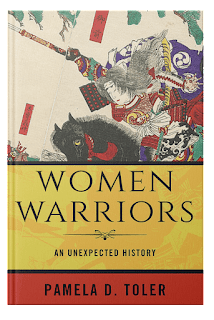 Women Warriors: An Unexpected History
is bold, brash, witty, and cutting--and deservedly so. "After you read enough variations of historians arguing why a particular woman warrior didn't exist or fight," Toler explains, "you grow a bit cynical." Of the notion that "women are natural pacifists" because they give birth, she notes, "At its simplest, this argument is based on a series of assumptions about the relative natures of men and women that is unflattering to both. It is also counterhistorical."
Women Warriors: An Unexpected History
is bold, brash, witty, and cutting--and deservedly so. "After you read enough variations of historians arguing why a particular woman warrior didn't exist or fight," Toler explains, "you grow a bit cynical." Of the notion that "women are natural pacifists" because they give birth, she notes, "At its simplest, this argument is based on a series of assumptions about the relative natures of men and women that is unflattering to both. It is also counterhistorical."
Toler as a writer must have massive, well-organized filing cabinets (whether mental, digital, or actual, I don't know). Since girlhood, she has squirreled away stories about women who are "tough/mouthy/opinionated/different" like Joan of Arc and the women who fought in the Civil War dressed as men. Eventually her "women warrior" file got so fat she felt she had to write a book. She then went looking for women who fought "to avenge their families, defend their homes (or cities or nations), win independence from a foreign power, expand their kingdom's boundaries, or satisfy their ambition" and found that she could, in fact, have written several books.
She settled on a survey. The first woman warriors in her book date from the second millennium BCE: three well-armed women buried in the Caucasus mountains, two with battle scars. The most recent warrior women she mentions are two who completed Ranger School, the US army's elite infantry training program, in 2015; one who completed the Marine Corps infantry officer training program in 2017; and six who earned the Expert Infantryman Badge in 2018--her book came out in 2019.
In between she reports on thousands of other historical warrior women, from vastly different cultures and time periods, organizing their stories into themes. Are these women freaks and social outcasts? No. They are mothers, daughters, widows, queens. Some are socially expected to fight; others break norms and fight in disguise. Repeatedly, Toler skewers the tropes about women being kind, nurturing, peaceful, weak, squeamish, or somehow "other" than men.
"Many people who cheer for the highly sexualized women warriors of popular culture," such as Wonder Woman, she writes, "are less comfortable when confronted with real-life images of camouflage-wearing women with shaved heads at boot camp or Ranger School. In fact, that contrast gets at the heart of much of the long-standing, cross-cultural social discomfort with women warriors—the fear that women who chose to fight will lose their femininity or, conversely, that their presence will 'feminize' the army; thereby rendering it less effective, less aggressive, less serious, or just less. It is an old discussion: when Plato argued that women should be given the same training as men and [be] used in all the same tasks, including training in war, he warned 'we must not be afraid of all the jokes of the kind that the wits will make about such a change in physical and artistic culture, and not least about the women carrying arms and riding horses.'"
Plus ça change, plus c'est la même chose.
Why don't we know more about the heroic women in Toler's book? "At some level," she explains, "the disappearance of women warriors is part of our larger tendency to write history as 'his story.'" The problem is particularly acute in the field of military history.
"Both the current appeal of pop cultural heroines and ongoing battles over the role of female soldiers in the modern military assume women who go to war are historical anomalies: Joan of Arc, not G.I. Joan. This position is summed up in military historian John Keegan's magnificently inaccurate claim that "warfare is … the one human activity from which women, with the most insignificant exceptions, have always and everywhere stood apart. … Women have followed the drum, nursed the wounded, tended the field and herded the flocks when the man of the family has followed his leader, have even dug the trenches for men to defend and laboured in the workshops to send them their weapons. Women, however, do not fight … and they never, in any military sense, fight men."
Magnificently inaccurate indeed--and Toler has the facts to prove it. Not only do the women warriors in her book "fight men," they often beat them.
"As long as you focus on one historical figure, or one cluster of women, or on one historical period," Toler concludes, "it is easy to believe any individual woman warrior was indeed an exception who stood outside the norm of her time—created by a national crisis or an anomaly of inheritance—and who consequently stands outside the norm of history as a whole."
But when you look at the sweep of history, as Toler does, you find these "exceptions" become significant indeed. They change our ideas of what it means to be a "man" or a "woman." They enlarge the role models for every little girl who despises frilly pink dresses and chooses horses and toy soldiers over baby dolls.
Writes Toler, "The main thing that struck me when I looked at women warriors across cultures rather than in isolation is how many examples there are and how lightly they sit on our collective awareness. I began with hundreds of examples. I ended with thousands."
Warrior Women: An Unexpected History by Pamela Toler was published by Beacon Press in 2019. I'm pleased to add that Pamela likes my book, recreating the life and times of Bj581, as much as I like hers.
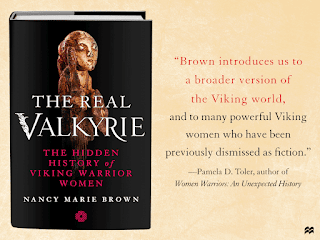 For more on my book
The Real Valkyrie: The Hidden History of Viking Warrior Women
, see the previous posts on this blog (click here) or my page at Macmillan.com.
For more on my book
The Real Valkyrie: The Hidden History of Viking Warrior Women
, see the previous posts on this blog (click here) or my page at Macmillan.com.
Disclosure: I am an affiliate of Bookshop.org and I may earn a commission if you click through and purchase the books mentioned here.
Bj581 gets a couple of pages. The thousands of other historical warrior women Toler finds hiding in plain sight will blow your mind.
Did I like this book? After I read it, I ordered two more copies for friends.
 Women Warriors: An Unexpected History
is bold, brash, witty, and cutting--and deservedly so. "After you read enough variations of historians arguing why a particular woman warrior didn't exist or fight," Toler explains, "you grow a bit cynical." Of the notion that "women are natural pacifists" because they give birth, she notes, "At its simplest, this argument is based on a series of assumptions about the relative natures of men and women that is unflattering to both. It is also counterhistorical."
Women Warriors: An Unexpected History
is bold, brash, witty, and cutting--and deservedly so. "After you read enough variations of historians arguing why a particular woman warrior didn't exist or fight," Toler explains, "you grow a bit cynical." Of the notion that "women are natural pacifists" because they give birth, she notes, "At its simplest, this argument is based on a series of assumptions about the relative natures of men and women that is unflattering to both. It is also counterhistorical." Toler as a writer must have massive, well-organized filing cabinets (whether mental, digital, or actual, I don't know). Since girlhood, she has squirreled away stories about women who are "tough/mouthy/opinionated/different" like Joan of Arc and the women who fought in the Civil War dressed as men. Eventually her "women warrior" file got so fat she felt she had to write a book. She then went looking for women who fought "to avenge their families, defend their homes (or cities or nations), win independence from a foreign power, expand their kingdom's boundaries, or satisfy their ambition" and found that she could, in fact, have written several books.
She settled on a survey. The first woman warriors in her book date from the second millennium BCE: three well-armed women buried in the Caucasus mountains, two with battle scars. The most recent warrior women she mentions are two who completed Ranger School, the US army's elite infantry training program, in 2015; one who completed the Marine Corps infantry officer training program in 2017; and six who earned the Expert Infantryman Badge in 2018--her book came out in 2019.
In between she reports on thousands of other historical warrior women, from vastly different cultures and time periods, organizing their stories into themes. Are these women freaks and social outcasts? No. They are mothers, daughters, widows, queens. Some are socially expected to fight; others break norms and fight in disguise. Repeatedly, Toler skewers the tropes about women being kind, nurturing, peaceful, weak, squeamish, or somehow "other" than men.
"Many people who cheer for the highly sexualized women warriors of popular culture," such as Wonder Woman, she writes, "are less comfortable when confronted with real-life images of camouflage-wearing women with shaved heads at boot camp or Ranger School. In fact, that contrast gets at the heart of much of the long-standing, cross-cultural social discomfort with women warriors—the fear that women who chose to fight will lose their femininity or, conversely, that their presence will 'feminize' the army; thereby rendering it less effective, less aggressive, less serious, or just less. It is an old discussion: when Plato argued that women should be given the same training as men and [be] used in all the same tasks, including training in war, he warned 'we must not be afraid of all the jokes of the kind that the wits will make about such a change in physical and artistic culture, and not least about the women carrying arms and riding horses.'"
Plus ça change, plus c'est la même chose.
Why don't we know more about the heroic women in Toler's book? "At some level," she explains, "the disappearance of women warriors is part of our larger tendency to write history as 'his story.'" The problem is particularly acute in the field of military history.
"Both the current appeal of pop cultural heroines and ongoing battles over the role of female soldiers in the modern military assume women who go to war are historical anomalies: Joan of Arc, not G.I. Joan. This position is summed up in military historian John Keegan's magnificently inaccurate claim that "warfare is … the one human activity from which women, with the most insignificant exceptions, have always and everywhere stood apart. … Women have followed the drum, nursed the wounded, tended the field and herded the flocks when the man of the family has followed his leader, have even dug the trenches for men to defend and laboured in the workshops to send them their weapons. Women, however, do not fight … and they never, in any military sense, fight men."
Magnificently inaccurate indeed--and Toler has the facts to prove it. Not only do the women warriors in her book "fight men," they often beat them.
"As long as you focus on one historical figure, or one cluster of women, or on one historical period," Toler concludes, "it is easy to believe any individual woman warrior was indeed an exception who stood outside the norm of her time—created by a national crisis or an anomaly of inheritance—and who consequently stands outside the norm of history as a whole."
But when you look at the sweep of history, as Toler does, you find these "exceptions" become significant indeed. They change our ideas of what it means to be a "man" or a "woman." They enlarge the role models for every little girl who despises frilly pink dresses and chooses horses and toy soldiers over baby dolls.
Writes Toler, "The main thing that struck me when I looked at women warriors across cultures rather than in isolation is how many examples there are and how lightly they sit on our collective awareness. I began with hundreds of examples. I ended with thousands."
Warrior Women: An Unexpected History by Pamela Toler was published by Beacon Press in 2019. I'm pleased to add that Pamela likes my book, recreating the life and times of Bj581, as much as I like hers.
 For more on my book
The Real Valkyrie: The Hidden History of Viking Warrior Women
, see the previous posts on this blog (click here) or my page at Macmillan.com.
For more on my book
The Real Valkyrie: The Hidden History of Viking Warrior Women
, see the previous posts on this blog (click here) or my page at Macmillan.com. Disclosure: I am an affiliate of Bookshop.org and I may earn a commission if you click through and purchase the books mentioned here.
Published on September 08, 2021 08:03
September 1, 2021
Of Bones and Bias
I begin
The Real Valkyrie: The Hidden History of Viking Warrior Women
with this sentence: "All I have are her bones."
And I thought, when I began writing it, that this was going to be a book about bones. I was surprised when it turned out to be a book about bias.
In the summer of 2015, I spent a day watching my friend Guðný Zöega excavate a Viking Age graveyard in Iceland. Bones, Guðný told me, were eloquent. They speak of battle wounds and disease. They tell how tall a person was, what she ate, where she came from. Listening to Guðný, I was inspired to write a book about bones and what archaeologists can learn from them.
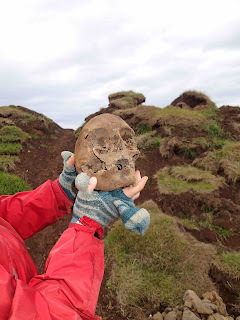 But, in retrospect, I noticed that a lot of what Guðný did that day was sit and think. She took photos, and made notes. Because once she took the bones from a grave and placed them in a box, no one else would ever see exactly how the skeleton had sat in the soil. Unlike the work of other scientists, hers is not reproducible. That's the problem with archaeology as a science.
But, in retrospect, I noticed that a lot of what Guðný did that day was sit and think. She took photos, and made notes. Because once she took the bones from a grave and placed them in a box, no one else would ever see exactly how the skeleton had sat in the soil. Unlike the work of other scientists, hers is not reproducible. That's the problem with archaeology as a science.
Nobody can repeat the experiment. What's left after an archaeologist finishes digging up a Viking burial are boxes of bones and artifact--and interpretations.
The gender of a burial is one of those interpretations. Archaeologists are taught that a woman's skull is smoother and more rounded. Her long bones are more slender. Her pelvis is shaped differently than a man's. But there’s no absolute scientific scale for "smoother, rounder, and more slender"--or even for pelvic structure, I learned.
Plus, few Viking skeletons are in good shape. After 1000 years in the soil, the bones are degraded, or missing. In cremation burials, the bones were first burned and then crushed before being buried in a pot. Yet archaeologists still sex these graves. How?
DNA sexing is now available. But it's difficult and expensive and, so, still rare.
The standard method, I learned, is "sexing by metal": Jewelry for women (especially the oval brooches that hold up the straps of an apron dress). And weapons for men.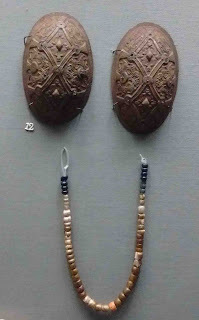
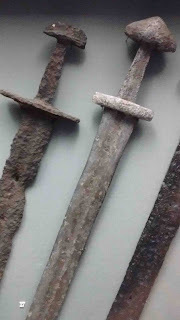
It sounds logical. Surely it's based on statistics, right?
It's not. The practice began in 1837, before archaeology as a science even existed. It reflects the values of Victorian society, when women were confined to the home and told to concern themselves only with their children, the church, and the kitchen.
When our image of the Viking world took shape, a warrior woman was as fabulous as a dragon. All weapons-graves were classified as male--and most of them still are.
By accepting the Victorian stereotypes, we legitimize the idea that women should stay at home. We reduce the role models for every modern girl who visits a museum or reads a history book. We make it hard to even imagine a warrior woman like the one buried in grave Bj581 in the Viking town of Birka, Sweden.
Bj581 is the burial at the heart of my book The Real Valkyrie . It was excavated in 1878. Other than one faded drawing and a few notes, all we have are boxes of bones and artifacts with the number "581" inked on them. Most of those artifacts are weapons.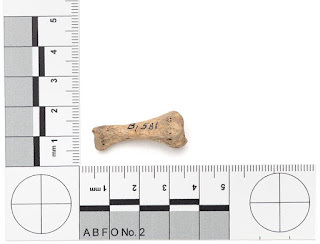
Because of the plethora of weapons in the grave, Bj581 has long been held up as the classic Viking warrior's grave.
In September 2017, a DNA study by Charlotte Hedenstierna-Price and her colleagues confirmed what some specialists had always thought: The bones were female. Interpreting Bj581 as a warrior woman, the researchers list a dozen scholars since 1966 who have labeled Bj581 a warrior's grave. "As far as we are aware, this warrior interpretation has never been challenged," they state, adding, "We strongly followed the same military reading as has been proposed for Bj581 by a long series of archaeological authorities, and for the same sensible reasons that are far from arbitrary. In doing so, we find no problem in adjusting for the new sex determination."
Their critics, however, did have a problem adjusting. They suggest that originally there must have been two people in the grave, a male warrior and his female wife or slave—and that the man has disappeared without a trace, leaving behind only his weapons. Or that the woman was sacrificed and buried in place of a man who died elsewhere. Or that, because she wielded weapons, Bj581 wasn't socially female.
What does the Viking world look like if we abandon the stereotypes? What does it look like if roles are assigned, not according to Victorian concepts of male versus female, but based on ambition, ability, family ties, and wealth? In The Real Valkyrie , I reread texts and reexamine archaeological finds with these questions in mind. I use what my research uncovers to re-create the world of one warrior woman in the Viking Age: the woman buried in Bj581.
 For more on my book
The Real Valkyrie: The Hidden History of Viking Warrior Women
, see the previous posts on this blog (click here) or my page at Macmillan.com.
For more on my book
The Real Valkyrie: The Hidden History of Viking Warrior Women
, see the previous posts on this blog (click here) or my page at Macmillan.com.
Disclosure: I am an affiliate of Bookshop.org and I may earn a commission if you click through and purchase the books mentioned here.
And I thought, when I began writing it, that this was going to be a book about bones. I was surprised when it turned out to be a book about bias.
In the summer of 2015, I spent a day watching my friend Guðný Zöega excavate a Viking Age graveyard in Iceland. Bones, Guðný told me, were eloquent. They speak of battle wounds and disease. They tell how tall a person was, what she ate, where she came from. Listening to Guðný, I was inspired to write a book about bones and what archaeologists can learn from them.
 But, in retrospect, I noticed that a lot of what Guðný did that day was sit and think. She took photos, and made notes. Because once she took the bones from a grave and placed them in a box, no one else would ever see exactly how the skeleton had sat in the soil. Unlike the work of other scientists, hers is not reproducible. That's the problem with archaeology as a science.
But, in retrospect, I noticed that a lot of what Guðný did that day was sit and think. She took photos, and made notes. Because once she took the bones from a grave and placed them in a box, no one else would ever see exactly how the skeleton had sat in the soil. Unlike the work of other scientists, hers is not reproducible. That's the problem with archaeology as a science. Nobody can repeat the experiment. What's left after an archaeologist finishes digging up a Viking burial are boxes of bones and artifact--and interpretations.
The gender of a burial is one of those interpretations. Archaeologists are taught that a woman's skull is smoother and more rounded. Her long bones are more slender. Her pelvis is shaped differently than a man's. But there’s no absolute scientific scale for "smoother, rounder, and more slender"--or even for pelvic structure, I learned.
Plus, few Viking skeletons are in good shape. After 1000 years in the soil, the bones are degraded, or missing. In cremation burials, the bones were first burned and then crushed before being buried in a pot. Yet archaeologists still sex these graves. How?
DNA sexing is now available. But it's difficult and expensive and, so, still rare.
The standard method, I learned, is "sexing by metal": Jewelry for women (especially the oval brooches that hold up the straps of an apron dress). And weapons for men.


It sounds logical. Surely it's based on statistics, right?
It's not. The practice began in 1837, before archaeology as a science even existed. It reflects the values of Victorian society, when women were confined to the home and told to concern themselves only with their children, the church, and the kitchen.
When our image of the Viking world took shape, a warrior woman was as fabulous as a dragon. All weapons-graves were classified as male--and most of them still are.
By accepting the Victorian stereotypes, we legitimize the idea that women should stay at home. We reduce the role models for every modern girl who visits a museum or reads a history book. We make it hard to even imagine a warrior woman like the one buried in grave Bj581 in the Viking town of Birka, Sweden.
Bj581 is the burial at the heart of my book The Real Valkyrie . It was excavated in 1878. Other than one faded drawing and a few notes, all we have are boxes of bones and artifacts with the number "581" inked on them. Most of those artifacts are weapons.

Because of the plethora of weapons in the grave, Bj581 has long been held up as the classic Viking warrior's grave.
In September 2017, a DNA study by Charlotte Hedenstierna-Price and her colleagues confirmed what some specialists had always thought: The bones were female. Interpreting Bj581 as a warrior woman, the researchers list a dozen scholars since 1966 who have labeled Bj581 a warrior's grave. "As far as we are aware, this warrior interpretation has never been challenged," they state, adding, "We strongly followed the same military reading as has been proposed for Bj581 by a long series of archaeological authorities, and for the same sensible reasons that are far from arbitrary. In doing so, we find no problem in adjusting for the new sex determination."
Their critics, however, did have a problem adjusting. They suggest that originally there must have been two people in the grave, a male warrior and his female wife or slave—and that the man has disappeared without a trace, leaving behind only his weapons. Or that the woman was sacrificed and buried in place of a man who died elsewhere. Or that, because she wielded weapons, Bj581 wasn't socially female.
What does the Viking world look like if we abandon the stereotypes? What does it look like if roles are assigned, not according to Victorian concepts of male versus female, but based on ambition, ability, family ties, and wealth? In The Real Valkyrie , I reread texts and reexamine archaeological finds with these questions in mind. I use what my research uncovers to re-create the world of one warrior woman in the Viking Age: the woman buried in Bj581.
 For more on my book
The Real Valkyrie: The Hidden History of Viking Warrior Women
, see the previous posts on this blog (click here) or my page at Macmillan.com.
For more on my book
The Real Valkyrie: The Hidden History of Viking Warrior Women
, see the previous posts on this blog (click here) or my page at Macmillan.com. Disclosure: I am an affiliate of Bookshop.org and I may earn a commission if you click through and purchase the books mentioned here.
Published on September 01, 2021 08:00
August 25, 2021
The Magic of Einar Selvik
In August 2018, I went to the Midgardsblot in Borre, Norway. Midgardsblot is a Viking metal music festival. I am not a Viking metal enthusiast, but I needed to visit Norway's ancient kingdoms of Vestfold and Agdir to do research for my book
The Real Valkyrie: The Hidden History of Viking Warrior Women
.
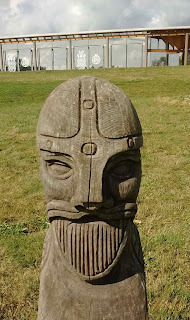 Borre, in Vestfold, has several grave mounds in their original, unexcavated condition. It has a small museum of Viking archaeology. It has a reconstructed Viking feast hall. And, along with the music festival, its Midgardsblot featured a Viking encampment, with reenactors of many kinds, and a series of lectures on Viking history and lore.
Borre, in Vestfold, has several grave mounds in their original, unexcavated condition. It has a small museum of Viking archaeology. It has a reconstructed Viking feast hall. And, along with the music festival, its Midgardsblot featured a Viking encampment, with reenactors of many kinds, and a series of lectures on Viking history and lore.
I was interested in the music reenactors. Music is associated with rituals in the Icelandic sagas, and those rituals are often associated with women, making them pertinent for my study of the power of women in the Viking Age. So I made sure to get a seat in the tiny lecture hall for the two lectures by musician Einar Selvik of Wardruna.
I knew Einar's music was featured on the History Channel's "Vikings" TV show. But I didn't know what an immersive artist he was.
As he explained, "I try not to climb into trees that don't have roots. I'm a very nerdy person. I read as much as the academics, or maybe more. I try out the theories the scholars put out. I sing in longhouses in front of audiences hungry for this experience. I cultivate and feed on what works in front of an audience."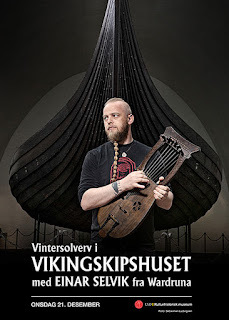 First he researched Viking Age instruments. "Instruments carry within them a lot of limitations," he said. "Whatever you do with them is authentic. The idea is to sow seeds, to make something grow again--not to put it into a museum. I went to museums and archives. I read books. I made a lot of shitty instruments. I didn't want to hear instruments played by other people, I wanted to approach it as a child. This was an initiation for me, a journey."
First he researched Viking Age instruments. "Instruments carry within them a lot of limitations," he said. "Whatever you do with them is authentic. The idea is to sow seeds, to make something grow again--not to put it into a museum. I went to museums and archives. I read books. I made a lot of shitty instruments. I didn't want to hear instruments played by other people, I wanted to approach it as a child. This was an initiation for me, a journey."
He made drums: "I didn't shoot the animal, but I did skin it. I put it in the river until the hair sacs let loose. Then I had the smelly work of cleaning it, but it's beautiful work too, because you're bringing the animal back to life. Every time I beat on that drum, with its own leg, she is there, singing."
He made horns from goat horns, with fingerholes and sometimes with reeds (like an oboe's) out of juniper. He made long birchbark lurs, played like trumpets (the harder you blow, the higher the tone). He made a bowed tail-harp with two horsehair strings, one for the melody and one for the drone. ("This is an instrument that does not always behave," he noted. Like a horse, I might add.)
When he created the group Wardruna, Einar said, "I decided I wanted to create music to runes. For me they are very good images of various aspects of the old way of viewing the world. Poems, proverbs, riddles--they give a view of man's relationship to nature, to each other, and to something bigger than ourselves, spiritual or philosophical. The old people did not kneel to gods. They walked among gods, and the gods helped the ones who helped themselves."
The runes are the letters of the Viking futhark (alphabet). Each also has a meaning: birch tree, water, need. "The root of the word is connected to creating sound," Einar explained. "It can mean a secret, some esoteric knowledge, to whisper, a magical song, a letter that has a sound, a riddle."
Writing a rune song he let the rune speak, Einar said. "I don't force it into a shape. I try to be the vessel. When I did the one for the birch tree, I went into the forest and played on a birch tree. I only used the branches that bent to the east. For the rune for water, all the sounds were recorded while standing in a river.
"When I recorded the song 'Need,' I fasted for days, went into the mountains with hardly any clothes on, and started to walk. I was crying, in excruciating pain. I started to hyperventilate, then I started to sing--I had people following me, of course, but I promised myself I wouldn't cheat. It's added value. I'm 100 percent convinced people can tell the difference."
The Vikings used runes in rituals or magic--exactly how, we don't know. But in some way, runes are connected with seiðr, an Old Norse form of magic. "What it is, how it was done, the gritty details--we don’t know any of that," Einar said. "We can only hypothesize or assume. It could be an ecstatic form of sorcery. Seiðr was used as a synonym for song."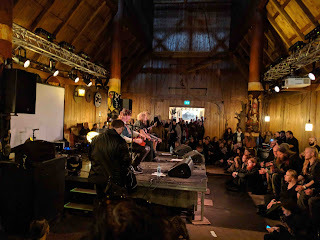 A völva, or seer, conducts a seiðr ritual in a famous scene in the Saga of the Greenlanders. Though the saga was written at least 200 years after the event, the seer is described in wonderful detail. She wore a long blue gown and a black lambskin hood lined with white cat's fur. She had catskin gloves, too, and carried a brass-bound staff. Both her gown and her staff were adorned with jewels. She could eat only the hearts of animals, one of each kind. She could sit only on a cushion stuffed with hens' feathers. To invoke the spirits, she needed a helper to sing certain magic songs. Only Gudrid the Far-Traveler knew them, and she sang them expertly. Charmed by her singing, the spirits gathered and revealed many things, among them Gudrid's future.
A völva, or seer, conducts a seiðr ritual in a famous scene in the Saga of the Greenlanders. Though the saga was written at least 200 years after the event, the seer is described in wonderful detail. She wore a long blue gown and a black lambskin hood lined with white cat's fur. She had catskin gloves, too, and carried a brass-bound staff. Both her gown and her staff were adorned with jewels. She could eat only the hearts of animals, one of each kind. She could sit only on a cushion stuffed with hens' feathers. To invoke the spirits, she needed a helper to sing certain magic songs. Only Gudrid the Far-Traveler knew them, and she sang them expertly. Charmed by her singing, the spirits gathered and revealed many things, among them Gudrid's future.
"I'm singing to modern people," Einar explained, "to modern ears that demand a certain thing to make it resonate. The content is timeless. The wrapping is different. I don't need catskin gloves or to sit on a feather pillow like the Greenland völva--that was her toolbox. We live in a different time. They were battling nature--nature was the trolls. For us, it's the other way around.
"When I come into this room, I have to outmatch you. I have to be bigger than you collectively. To reach you, I have to sing from the heart to reach your heart. I could change the atmosphere in this room very rapidly--I could make you scared, make you bored, make you tired. Using song to create a higher state of mind--that’s real. Add pain, add exhaustion, add breath, and you get ecstasy."
And then he began to sing. I've been listening to his music ever since.
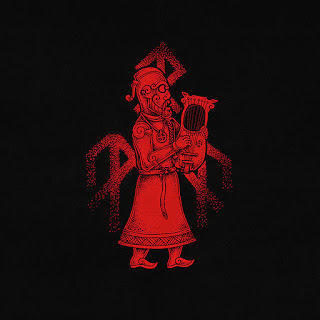 To listen to or learn more about Einar Selvik's music, see the Wardruna website, here: http://www.wardruna.com
To listen to or learn more about Einar Selvik's music, see the Wardruna website, here: http://www.wardruna.com
To experience that ecstasy in a very modern setting, listen to him performing his version of Völuspá accompanied by the Bergen Filharmoniske Orkester and the Edvard Grieg Kor, conducted by Edward Gardner. The performance was part of the opening concert of the 2020 Bergen International Festival in Grieghallen, Bergen, Norway. Listen here: https://www.youtube.com/watch?v=-8ah846uyw0&feature=youtu.be&fbclid=IwAR1vRBnitUQRcGYN1nNXwJOpr8zRSUGAD14W5PrJNWosrKa8Y97movVJ22k
Versions of Einar's lectures on Viking Age music can also be found online. See, for example, the Winter Solstice Concert at the Viking Ship Museum, Bygdøy, Norway (advertised on the poster above), here: https://www.youtube.com/watch?v=a3e4b1QiSEQ
 For more on my book
The Real Valkyrie: The Hidden History of Viking Warrior Women
, see the previous posts on this blog (click here) or my page at Macmillan.com.
For more on my book
The Real Valkyrie: The Hidden History of Viking Warrior Women
, see the previous posts on this blog (click here) or my page at Macmillan.com.
Disclosure: I am an affiliate of Bookshop.org and I may earn a commission if you click through and purchase the books mentioned here.
 Borre, in Vestfold, has several grave mounds in their original, unexcavated condition. It has a small museum of Viking archaeology. It has a reconstructed Viking feast hall. And, along with the music festival, its Midgardsblot featured a Viking encampment, with reenactors of many kinds, and a series of lectures on Viking history and lore.
Borre, in Vestfold, has several grave mounds in their original, unexcavated condition. It has a small museum of Viking archaeology. It has a reconstructed Viking feast hall. And, along with the music festival, its Midgardsblot featured a Viking encampment, with reenactors of many kinds, and a series of lectures on Viking history and lore. I was interested in the music reenactors. Music is associated with rituals in the Icelandic sagas, and those rituals are often associated with women, making them pertinent for my study of the power of women in the Viking Age. So I made sure to get a seat in the tiny lecture hall for the two lectures by musician Einar Selvik of Wardruna.
I knew Einar's music was featured on the History Channel's "Vikings" TV show. But I didn't know what an immersive artist he was.
As he explained, "I try not to climb into trees that don't have roots. I'm a very nerdy person. I read as much as the academics, or maybe more. I try out the theories the scholars put out. I sing in longhouses in front of audiences hungry for this experience. I cultivate and feed on what works in front of an audience."
 First he researched Viking Age instruments. "Instruments carry within them a lot of limitations," he said. "Whatever you do with them is authentic. The idea is to sow seeds, to make something grow again--not to put it into a museum. I went to museums and archives. I read books. I made a lot of shitty instruments. I didn't want to hear instruments played by other people, I wanted to approach it as a child. This was an initiation for me, a journey."
First he researched Viking Age instruments. "Instruments carry within them a lot of limitations," he said. "Whatever you do with them is authentic. The idea is to sow seeds, to make something grow again--not to put it into a museum. I went to museums and archives. I read books. I made a lot of shitty instruments. I didn't want to hear instruments played by other people, I wanted to approach it as a child. This was an initiation for me, a journey." He made drums: "I didn't shoot the animal, but I did skin it. I put it in the river until the hair sacs let loose. Then I had the smelly work of cleaning it, but it's beautiful work too, because you're bringing the animal back to life. Every time I beat on that drum, with its own leg, she is there, singing."
He made horns from goat horns, with fingerholes and sometimes with reeds (like an oboe's) out of juniper. He made long birchbark lurs, played like trumpets (the harder you blow, the higher the tone). He made a bowed tail-harp with two horsehair strings, one for the melody and one for the drone. ("This is an instrument that does not always behave," he noted. Like a horse, I might add.)
When he created the group Wardruna, Einar said, "I decided I wanted to create music to runes. For me they are very good images of various aspects of the old way of viewing the world. Poems, proverbs, riddles--they give a view of man's relationship to nature, to each other, and to something bigger than ourselves, spiritual or philosophical. The old people did not kneel to gods. They walked among gods, and the gods helped the ones who helped themselves."
The runes are the letters of the Viking futhark (alphabet). Each also has a meaning: birch tree, water, need. "The root of the word is connected to creating sound," Einar explained. "It can mean a secret, some esoteric knowledge, to whisper, a magical song, a letter that has a sound, a riddle."
Writing a rune song he let the rune speak, Einar said. "I don't force it into a shape. I try to be the vessel. When I did the one for the birch tree, I went into the forest and played on a birch tree. I only used the branches that bent to the east. For the rune for water, all the sounds were recorded while standing in a river.
"When I recorded the song 'Need,' I fasted for days, went into the mountains with hardly any clothes on, and started to walk. I was crying, in excruciating pain. I started to hyperventilate, then I started to sing--I had people following me, of course, but I promised myself I wouldn't cheat. It's added value. I'm 100 percent convinced people can tell the difference."
The Vikings used runes in rituals or magic--exactly how, we don't know. But in some way, runes are connected with seiðr, an Old Norse form of magic. "What it is, how it was done, the gritty details--we don’t know any of that," Einar said. "We can only hypothesize or assume. It could be an ecstatic form of sorcery. Seiðr was used as a synonym for song."
 A völva, or seer, conducts a seiðr ritual in a famous scene in the Saga of the Greenlanders. Though the saga was written at least 200 years after the event, the seer is described in wonderful detail. She wore a long blue gown and a black lambskin hood lined with white cat's fur. She had catskin gloves, too, and carried a brass-bound staff. Both her gown and her staff were adorned with jewels. She could eat only the hearts of animals, one of each kind. She could sit only on a cushion stuffed with hens' feathers. To invoke the spirits, she needed a helper to sing certain magic songs. Only Gudrid the Far-Traveler knew them, and she sang them expertly. Charmed by her singing, the spirits gathered and revealed many things, among them Gudrid's future.
A völva, or seer, conducts a seiðr ritual in a famous scene in the Saga of the Greenlanders. Though the saga was written at least 200 years after the event, the seer is described in wonderful detail. She wore a long blue gown and a black lambskin hood lined with white cat's fur. She had catskin gloves, too, and carried a brass-bound staff. Both her gown and her staff were adorned with jewels. She could eat only the hearts of animals, one of each kind. She could sit only on a cushion stuffed with hens' feathers. To invoke the spirits, she needed a helper to sing certain magic songs. Only Gudrid the Far-Traveler knew them, and she sang them expertly. Charmed by her singing, the spirits gathered and revealed many things, among them Gudrid's future. "I'm singing to modern people," Einar explained, "to modern ears that demand a certain thing to make it resonate. The content is timeless. The wrapping is different. I don't need catskin gloves or to sit on a feather pillow like the Greenland völva--that was her toolbox. We live in a different time. They were battling nature--nature was the trolls. For us, it's the other way around.
"When I come into this room, I have to outmatch you. I have to be bigger than you collectively. To reach you, I have to sing from the heart to reach your heart. I could change the atmosphere in this room very rapidly--I could make you scared, make you bored, make you tired. Using song to create a higher state of mind--that’s real. Add pain, add exhaustion, add breath, and you get ecstasy."
And then he began to sing. I've been listening to his music ever since.
 To listen to or learn more about Einar Selvik's music, see the Wardruna website, here: http://www.wardruna.com
To listen to or learn more about Einar Selvik's music, see the Wardruna website, here: http://www.wardruna.comTo experience that ecstasy in a very modern setting, listen to him performing his version of Völuspá accompanied by the Bergen Filharmoniske Orkester and the Edvard Grieg Kor, conducted by Edward Gardner. The performance was part of the opening concert of the 2020 Bergen International Festival in Grieghallen, Bergen, Norway. Listen here: https://www.youtube.com/watch?v=-8ah846uyw0&feature=youtu.be&fbclid=IwAR1vRBnitUQRcGYN1nNXwJOpr8zRSUGAD14W5PrJNWosrKa8Y97movVJ22k
Versions of Einar's lectures on Viking Age music can also be found online. See, for example, the Winter Solstice Concert at the Viking Ship Museum, Bygdøy, Norway (advertised on the poster above), here: https://www.youtube.com/watch?v=a3e4b1QiSEQ
 For more on my book
The Real Valkyrie: The Hidden History of Viking Warrior Women
, see the previous posts on this blog (click here) or my page at Macmillan.com.
For more on my book
The Real Valkyrie: The Hidden History of Viking Warrior Women
, see the previous posts on this blog (click here) or my page at Macmillan.com. Disclosure: I am an affiliate of Bookshop.org and I may earn a commission if you click through and purchase the books mentioned here.
Published on August 25, 2021 08:00
August 18, 2021
Getting Back on the Horse
The day before I was scheduled to begin two weeks of research in Norway for my new book
The Real Valkyrie
, I fell off my horse.
My husband and I generally ride our Icelandic horses through the woods every day, often in the late afternoon after a successful day writing or taking notes for a book project. This time we had a friend with us on our third horse.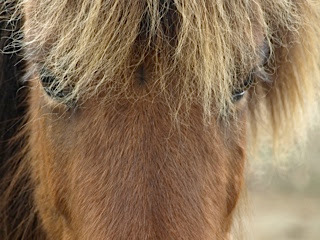 Two of the horses spooked and, the trail being narrow, bumped into each other. Through the strangest set of circumstances, my knee got caught under my friend’s saddle and, to disengage it, I swivelled sideways and took my foot out of my stirrup. I forgot that this combination of cues—a sudden shift of balance and a tap with the foot (or in this case the loose stirrup)—was the signal for the flying pace, the racing gait of the Icelandic horse.
Two of the horses spooked and, the trail being narrow, bumped into each other. Through the strangest set of circumstances, my knee got caught under my friend’s saddle and, to disengage it, I swivelled sideways and took my foot out of my stirrup. I forgot that this combination of cues—a sudden shift of balance and a tap with the foot (or in this case the loose stirrup)—was the signal for the flying pace, the racing gait of the Icelandic horse.
My horse is a race horse (in her mind at least). She took off down the trail. The footing wasn’t great for racing. She skittered and bobbled. I couldn’t regain my balance. I lost the second stirrup and was hanging on for dear life, and, to make a long story short, we didn’t negotiate the 90-degree turn. She tripped and I flew off and smashed into the bank. She stopped and looked at me like, “What was that all about?”
I limped home and lay down for a while, making little of it. I ate dinner but, in the midst of enjoying my blueberry pie, threw up all over the dinner table—a clear sign of a concussion. My husband bundled me up and took me to the emergency room. Six hours later, having passed every test for a patient of high-speed trauma, I was released, with a stern recommendation to spend the next two weeks lying down in a darkened room (and, given the state of health insurance in the U.S., with an out-of-pocket bill for $4,500).
I said, “I’m flying to Norway tomorrow.” And I did. With a black eye, black-and-blue all down one side, and walking with a cane.
Fortunately, I had earlier arranged to take a young writer friend with me. Rather than being my research assistant, he stepped up to the job of baggage handler, driver, cook, and nurse, even convincing the bouncers at the gates to the Viking Metal Music Festival that the old lady with the black eye (me) needed to keep her walking stick, though sticks were forbidden on festival grounds. In my hand, it didn’t much look like a weapon.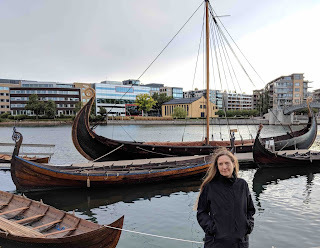 Visiting the places I write about and taking part in reenactments when possible—sailing in a Viking ship or, as here, climbing Viking burial mounds and attending a performance based on Viking Age shamanism in a reconstructed Viking mead hall—are key to the kind of books I write. The best way to recreate the life of a historical character is to live it.
Visiting the places I write about and taking part in reenactments when possible—sailing in a Viking ship or, as here, climbing Viking burial mounds and attending a performance based on Viking Age shamanism in a reconstructed Viking mead hall—are key to the kind of books I write. The best way to recreate the life of a historical character is to live it.
I imagine the real valkyrie who is the subject of my book fell off her horse a time or two as well, and it didn’t keep her from doing her job.
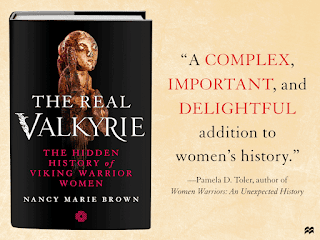 For more on my book
The Real Valkyrie: The Hidden History of Viking Warrior Women
, see the previous posts on this blog (click here) or my page at Macmillan.com. Disclosure: I am an affiliate of Bookshop.org and I will earn a commission if you click through and purchase a book on their site.
For more on my book
The Real Valkyrie: The Hidden History of Viking Warrior Women
, see the previous posts on this blog (click here) or my page at Macmillan.com. Disclosure: I am an affiliate of Bookshop.org and I will earn a commission if you click through and purchase a book on their site.
My husband and I generally ride our Icelandic horses through the woods every day, often in the late afternoon after a successful day writing or taking notes for a book project. This time we had a friend with us on our third horse.
 Two of the horses spooked and, the trail being narrow, bumped into each other. Through the strangest set of circumstances, my knee got caught under my friend’s saddle and, to disengage it, I swivelled sideways and took my foot out of my stirrup. I forgot that this combination of cues—a sudden shift of balance and a tap with the foot (or in this case the loose stirrup)—was the signal for the flying pace, the racing gait of the Icelandic horse.
Two of the horses spooked and, the trail being narrow, bumped into each other. Through the strangest set of circumstances, my knee got caught under my friend’s saddle and, to disengage it, I swivelled sideways and took my foot out of my stirrup. I forgot that this combination of cues—a sudden shift of balance and a tap with the foot (or in this case the loose stirrup)—was the signal for the flying pace, the racing gait of the Icelandic horse. My horse is a race horse (in her mind at least). She took off down the trail. The footing wasn’t great for racing. She skittered and bobbled. I couldn’t regain my balance. I lost the second stirrup and was hanging on for dear life, and, to make a long story short, we didn’t negotiate the 90-degree turn. She tripped and I flew off and smashed into the bank. She stopped and looked at me like, “What was that all about?”
I limped home and lay down for a while, making little of it. I ate dinner but, in the midst of enjoying my blueberry pie, threw up all over the dinner table—a clear sign of a concussion. My husband bundled me up and took me to the emergency room. Six hours later, having passed every test for a patient of high-speed trauma, I was released, with a stern recommendation to spend the next two weeks lying down in a darkened room (and, given the state of health insurance in the U.S., with an out-of-pocket bill for $4,500).
I said, “I’m flying to Norway tomorrow.” And I did. With a black eye, black-and-blue all down one side, and walking with a cane.
Fortunately, I had earlier arranged to take a young writer friend with me. Rather than being my research assistant, he stepped up to the job of baggage handler, driver, cook, and nurse, even convincing the bouncers at the gates to the Viking Metal Music Festival that the old lady with the black eye (me) needed to keep her walking stick, though sticks were forbidden on festival grounds. In my hand, it didn’t much look like a weapon.
 Visiting the places I write about and taking part in reenactments when possible—sailing in a Viking ship or, as here, climbing Viking burial mounds and attending a performance based on Viking Age shamanism in a reconstructed Viking mead hall—are key to the kind of books I write. The best way to recreate the life of a historical character is to live it.
Visiting the places I write about and taking part in reenactments when possible—sailing in a Viking ship or, as here, climbing Viking burial mounds and attending a performance based on Viking Age shamanism in a reconstructed Viking mead hall—are key to the kind of books I write. The best way to recreate the life of a historical character is to live it. I imagine the real valkyrie who is the subject of my book fell off her horse a time or two as well, and it didn’t keep her from doing her job.
 For more on my book
The Real Valkyrie: The Hidden History of Viking Warrior Women
, see the previous posts on this blog (click here) or my page at Macmillan.com. Disclosure: I am an affiliate of Bookshop.org and I will earn a commission if you click through and purchase a book on their site.
For more on my book
The Real Valkyrie: The Hidden History of Viking Warrior Women
, see the previous posts on this blog (click here) or my page at Macmillan.com. Disclosure: I am an affiliate of Bookshop.org and I will earn a commission if you click through and purchase a book on their site.
Published on August 18, 2021 08:00
August 11, 2021
The Story Behind The Real Valkyrie

I'm always attracted to the historical questions that don't seem to have answers.
In Chapter Three of my 2015 book Ivory Vikings , I mused about why the chess queen caught on so much more quickly than the bishop, though both pieces were introduced to the game in 10th century Europe. Medieval queens, I learned, were expected to wage war, at least by proxy. Empress Theophanu, who ruled the Holy Roman Empire from 983-990, for example, accompanied her men to the battlefield and once rescued her husband when he was captured.
In the Viking North—at least in poetry and sagas—women actually fought. These awesome women warriors, the valkyries, were battle goddesses, sometimes beautiful, sometimes troll-like. They were sent by Odin, the supreme Norse god, to fetch slain heroes to Valhalla—or they drizzled troughs of blood over the battlefield and whipped men's heads off with bloody rags. Norse legends also tell of shield-maids: Sometimes they ride flying horses and cast storms of spears. Sometimes they are real Viking women who dress and fight like men. Today, the word valkyrie is often used for all three: the mythological, the legendary, and the historical.
When I completed Ivory Vikings , the question of the valkyries stayed with me. Were they real, or only myths? Were there real warrior women in the Viking Age, real valkyries?
My discussion of valkyries in Ivory Vikings had been influenced by the work of Neil Price, a professor of archaeology at the University of Uppsala in Sweden. As I wrote in an earlier post [here], I arranged to meet him at the Society of American Archaeologists conference in 2016, where he hinted that a study he couldn't yet talk about would "completely change the conversation" around valkyries.
The September 2017 study he co-authored in the American Journal of Physical Anthropology—a DNA study of the bones in grave Bj581 in Birka, Sweden—did, as Price warned, change the conversation, though not in the way he had imagined.
There was a fierce backlash, with many Viking scholars (even female ones) insisting that the researchers must have made some simple mistake when they concluded that the warrior buried in Bj581 was female, because "we know warriors were men." The popular backlash was perhaps even fiercer, and it continued even after Price's team published their more comprehensive article in 2019, providing more data and detail to support their conclusion that, yes, the warrior in this classic Viking grave was female.
The more I looked into it, the more I realized that we didn't, in fact, "know" warriors were men. We knew some Viking men were warriors, but we also had countless hints that some Viking women were warriors, too. It was only our assumptions about what was appropriate behavior for women—assumptions held over from the Victorian Age, when elite women were confined to the home—that kept us from seeing what the data really said. The idea that the Viking Age was an age of hypermasculinity is a myth.
As I researched and wrote The Real Valkyrie , I was inspired by Stacy Schiff's Cleopatra: A Life (Little, Brown, 2010). Writes Schiff, "The holes in the record present one hazard, what we have constructed around them another." She sees it as the biographer's job, and I agree, to "peel away the encrusted myth and the hoary propaganda."
Yet myths die hard, as Ulrich Raulff notes in Farewell to the Horse (Liveright, 2018), another book that inspired me. Writes Raulff, "History is written in the indicative mood, but lived and remembered in the optative—the grammatical mood of wishful thinking. This is why historical myths are so tenacious. It's as though the truth, even when it's there for everyone to see, is powerless—it can't lay a finger on the all-powerful myth."
The Real Valkyrie is my attempt to lay a powerful myth to rest: The myth that Viking women stayed at home, keys on their belts, while Viking men, carrying swords, raided and traded from North America to Baghdad and beyond.
As Price and his coauthors wrote in 2019, "Birka grave Bj581 suggests to us that at least one Viking Age woman adopted a professional warrior lifestyle and may well have been present on the battlefield. We would be very surprised if she was alone in the Viking world."
Disclosure: I am an affiliate of Bookshop.org and I may earn a commission if you click through and purchase the books mentioned here.
Published on August 11, 2021 08:30
August 4, 2021
Are Valkyries Real?
In 2012 archaeologist Neil Price of Uppsala University gave a series of lectures at Cornell University in Ithaca, New York. I missed them. I was at Cornell that November, to lecture on my book
Song of the Vikings: Snorri and the Making of Norse Myths
and to visit the excellent Fiske Icelandic Collection in Cornell's library to begin researching
Ivory Vikings: The Mystery of the Most Famous Chessmen in the World and the Woman Who Made Them
. I saw a poster for Price's lectures in the hallway: He had spoken in September.
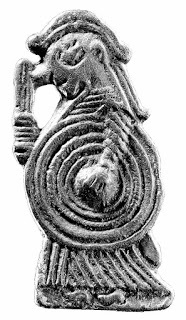 When I caught his lectures on YouTube a few months later, I was struck by Price's focus on "stories, the power of stories, and the role that narrative played in the life of the Vikings, its influence on their perception of the world."
When I caught his lectures on YouTube a few months later, I was struck by Price's focus on "stories, the power of stories, and the role that narrative played in the life of the Vikings, its influence on their perception of the world."
This was a different approach to that of most Viking Age archaeologists, and one I particularly liked.
Price's ideas influenced my discussion of valkyries in my book Ivory Vikings , though we disagree on a key issue: What the word "valkyrie" means.
To Price, a valkyrie is a goddess or demon, a shield-maid is "semi-human," and neither is a "real" warrior woman, though Viking Age burials of female skeletons with weapons suggest those were indeed part of the Viking world.
To me, the three terms--valkyrie, shield-maid, and warrior woman--are synonyms.
In the first of his Cornell lectures, "Children of Ash: Cosmology and the Viking Universe", Price noted about valkyries: "We don't know whether we have any Viking Age depictions of them." Referring to the tiny 3D figurine of a warrior whose image graces the cover of my new book, The Real Valkyrie: The Hidden History of Viking Warrior Women , Price added, "These things don’t come with labels; we have to try and interpret them."
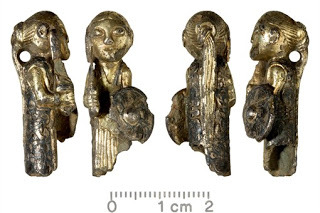 I would add that we don't know what the Vikings meant by the words "valkyrie" and "shield-maid" either; we can only try to interpret them.
I would add that we don't know what the Vikings meant by the words "valkyrie" and "shield-maid" either; we can only try to interpret them.
In 2015, when I decided to write a book on the concept of the valkyrie in the Viking Age, I reached out to Price for advice. Rather than fly to Uppsala, Sweden, where he teaches, I arranged to meet him at the Society of American Archaeologists' conference in Orlando, Florida, in January 2016. I told him I was looking for a Viking warrior burial to study in depth. From the 2013 survey by his former student, Leszek Gardeła, "'Warrior-women' in Viking Age Scandinavia?," I knew of a handful of graves that would suffice for my purposes. The questions I wanted to answer were (I thought) simple: How do we know a buried warrior was male or female? What stories influence our perception?
I asked Price if he could refer me to an archaeologist, preferably a woman, who was an expert on a Viking Age weapons-grave, preferably the burial of a woman.
He looked at me funny. "I can’t talk about that—yet."
He suggested, very casually, that I meet Charlotte Hedenstierna-Jonson, who was also attending the conference in Florida. I listened to her paper, on a topic I wasn't then interested in, and I didn't make the connection—until September 2017 when "A Female Viking Warrior Confirmed by Genomics" was published in the American Journal of Physical Anthropology, with Hedenstierna-Jonson and Price listed among the coauthors.
 Their "female viking warrior" is the skeleton buried with a full set of weapons in grave Bj581 in Birka, Sweden sometime between 913 and 980. It is her story I bring to life in
The Real Valkyrie.
Their "female viking warrior" is the skeleton buried with a full set of weapons in grave Bj581 in Birka, Sweden sometime between 913 and 980. It is her story I bring to life in
The Real Valkyrie.
I call her a "valkyrie." Price and his co-authors don't. So even after nine years of research and writing, I can't answer the question I posed in the title of this essay, "Are valkyries real?" It depends on how you define your terms.
Disclosure: I am an affiliate of Bookshop.org and will earn a commission if you click through and purchase the books mentioned here.
 When I caught his lectures on YouTube a few months later, I was struck by Price's focus on "stories, the power of stories, and the role that narrative played in the life of the Vikings, its influence on their perception of the world."
When I caught his lectures on YouTube a few months later, I was struck by Price's focus on "stories, the power of stories, and the role that narrative played in the life of the Vikings, its influence on their perception of the world." This was a different approach to that of most Viking Age archaeologists, and one I particularly liked.
Price's ideas influenced my discussion of valkyries in my book Ivory Vikings , though we disagree on a key issue: What the word "valkyrie" means.
To Price, a valkyrie is a goddess or demon, a shield-maid is "semi-human," and neither is a "real" warrior woman, though Viking Age burials of female skeletons with weapons suggest those were indeed part of the Viking world.
To me, the three terms--valkyrie, shield-maid, and warrior woman--are synonyms.
In the first of his Cornell lectures, "Children of Ash: Cosmology and the Viking Universe", Price noted about valkyries: "We don't know whether we have any Viking Age depictions of them." Referring to the tiny 3D figurine of a warrior whose image graces the cover of my new book, The Real Valkyrie: The Hidden History of Viking Warrior Women , Price added, "These things don’t come with labels; we have to try and interpret them."
 I would add that we don't know what the Vikings meant by the words "valkyrie" and "shield-maid" either; we can only try to interpret them.
I would add that we don't know what the Vikings meant by the words "valkyrie" and "shield-maid" either; we can only try to interpret them. In 2015, when I decided to write a book on the concept of the valkyrie in the Viking Age, I reached out to Price for advice. Rather than fly to Uppsala, Sweden, where he teaches, I arranged to meet him at the Society of American Archaeologists' conference in Orlando, Florida, in January 2016. I told him I was looking for a Viking warrior burial to study in depth. From the 2013 survey by his former student, Leszek Gardeła, "'Warrior-women' in Viking Age Scandinavia?," I knew of a handful of graves that would suffice for my purposes. The questions I wanted to answer were (I thought) simple: How do we know a buried warrior was male or female? What stories influence our perception?
I asked Price if he could refer me to an archaeologist, preferably a woman, who was an expert on a Viking Age weapons-grave, preferably the burial of a woman.
He looked at me funny. "I can’t talk about that—yet."
He suggested, very casually, that I meet Charlotte Hedenstierna-Jonson, who was also attending the conference in Florida. I listened to her paper, on a topic I wasn't then interested in, and I didn't make the connection—until September 2017 when "A Female Viking Warrior Confirmed by Genomics" was published in the American Journal of Physical Anthropology, with Hedenstierna-Jonson and Price listed among the coauthors.
 Their "female viking warrior" is the skeleton buried with a full set of weapons in grave Bj581 in Birka, Sweden sometime between 913 and 980. It is her story I bring to life in
The Real Valkyrie.
Their "female viking warrior" is the skeleton buried with a full set of weapons in grave Bj581 in Birka, Sweden sometime between 913 and 980. It is her story I bring to life in
The Real Valkyrie.
I call her a "valkyrie." Price and his co-authors don't. So even after nine years of research and writing, I can't answer the question I posed in the title of this essay, "Are valkyries real?" It depends on how you define your terms.
Disclosure: I am an affiliate of Bookshop.org and will earn a commission if you click through and purchase the books mentioned here.
Published on August 04, 2021 08:00



